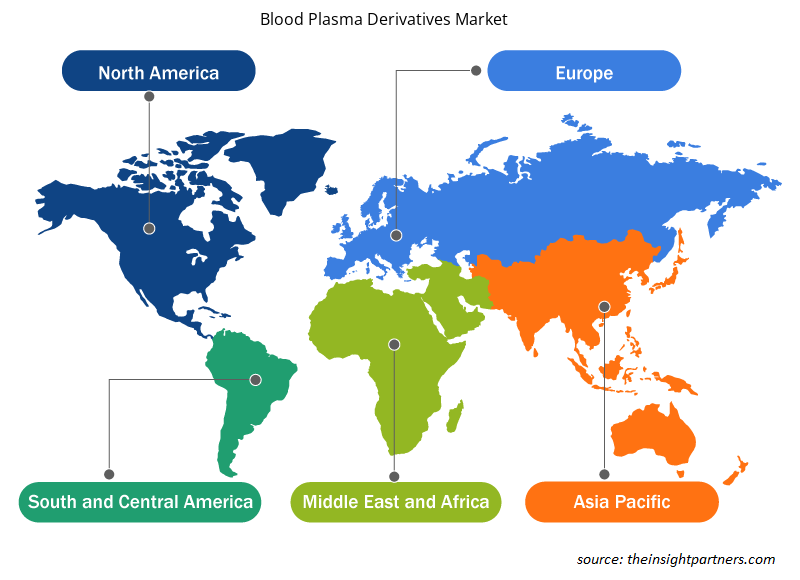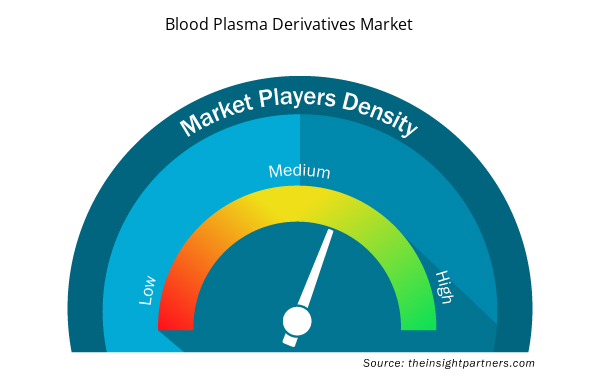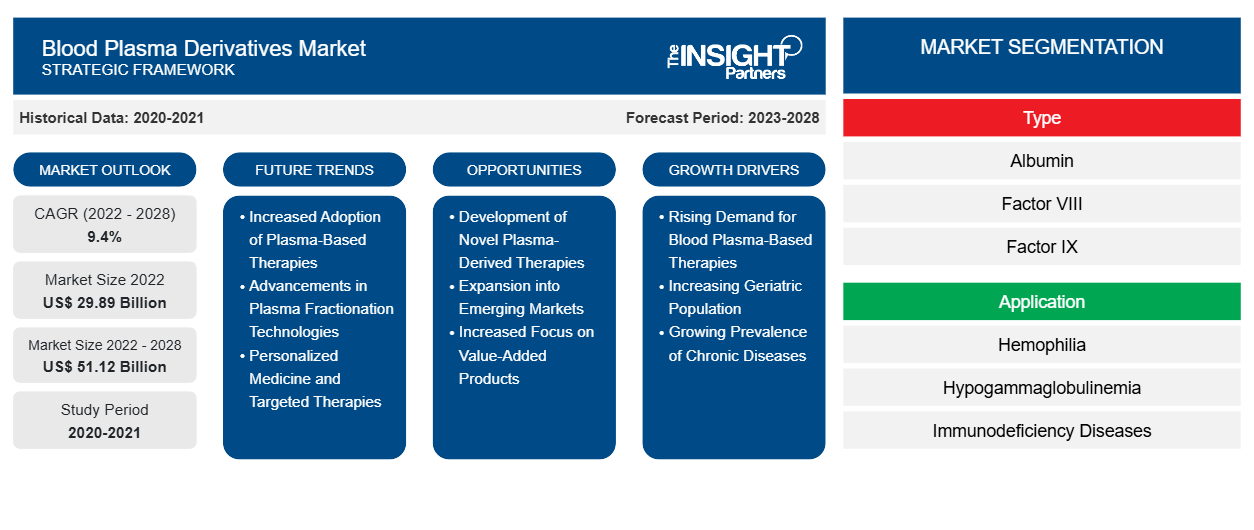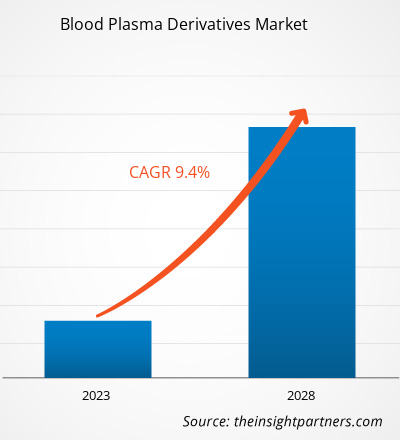[研究报告] 血浆衍生物市场预计将从 2022 年的 2988.612 万美元增至 2028 年的 511.1924 亿美元;预计 2022 年至 2028 年的 复合年增长率为 9.4%。
血浆衍生物是通过分馏循环从显性血浆蛋白中获得的。血浆衍生物含有大量蛋白质、盐、矿物质、激素、维生素和蛋白酶抑制剂。因此,它们通常用于破坏引发出血性疾病、乙型肝炎、丙型肝炎、甲型血友病、免疫缺陷、低丙种球蛋白血症、乙型血友病和人类免疫缺陷病毒的病毒。
血浆衍生物市场根据类型、应用、最终用户和地域进行细分。按地域划分,市场大致分为北美、欧洲、亚太地区、中东和非洲以及南美和中美洲。该报告提供了对市场的见解和深入分析,重点关注市场趋势、技术进步和市场动态等参数,以及世界领先市场参与者的竞争格局分析。
定制此报告以满足您的需求
您可以免费定制任何报告,包括本报告的部分内容、国家级分析、Excel 数据包,以及为初创企业和大学提供优惠和折扣
- 获取此报告的关键市场趋势。这个免费样品将包括数据分析,从市场趋势到估计和预测。
市场洞察 – 血浆衍生物市场
免疫球蛋白 G 在多种治疗中的使用增加,为未来几年血浆衍生物市场提供机会
免疫球蛋白G ( IgG ) 疗法被广泛用于治疗由基因缺陷引起的原发性免疫缺陷。由于人们对IgG疗法的认识不断提高,过去几年对IgG的需求一直在稳步增长。根据网络荟萃分析 ( NMA ) 所做的对照试验,IgG疗法已被批准用于治疗格林-巴利综合征 ( GBS )、慢性炎症性脱髓鞘性多发性神经病( CIDP )、多灶性运动神经病( MMN ) 和皮肌炎。IgG疗法还可有效治疗重症肌无力加重和僵人综合征。此外,它在癫痫、神经脊髓炎和自身免疫性脑炎等自身免疫性疾病方面也具有令人信服的疗效。
- 2022 年,Grifols与加拿大血液服务中心达成协议。该协议加速了加拿大免疫球蛋白的自给自足。根据该协议,Grifols将与加拿大血液服务中心合作,逐步增加加拿大的血浆采购量,到 2026 年达到每年 240 万克免疫球蛋白药物的采购量。
- 2021 年,美国食品药品监督管理局 (FDA) 批准Cutaquig用于医疗用途。它用于成人和 2 岁以上儿童患者的原发性体液免疫缺陷 (PI) 的替代疗法。Cutaquig 是一种即用型免疫球蛋白溶液,用于皮下输注。该产品有1g、1.65g、2g、3.3g、4g 或 8g 一次性小瓶装。
- 2020 年 8 月,意大利Kedrion Biopharma公司开始改进一种基于血浆的治疗 COVID-19 患者的疗法。该疗法有望在三年到半的时间内为患者所用。
IgG的大部分用途是用于免疫学以外的专业,例如肿瘤学、神经病学、血液学和风湿病学。相比之下,神经病学是全球市场上增长最快的专业。免疫球蛋白 G 市场的增长归因于其获准用于慢性炎症性脱髓鞘性 多发性神经病( CIDP ),随后用于淋巴瘤、骨髓瘤和白血病引起的继发性免疫缺陷以及某些免疫抑制疗法,尤其是 B 细胞靶向疗法。因此, IgG在多种标示内和标示外处方治疗中的广泛使用将在未来几年推动全球IgG需求。
最终用户洞察
根据最终用户,全球血浆衍生物市场细分为医院、诊所和其他。医院部门在 2022 年占据了最大的市场份额,预计在预测期内将实现最高的复合年增长率。预计在预测期内,住院人数的增加以及血管 性血友病、免疫缺陷疾病和血友病患病率的上升将推动医院部门的市场增长。此外,新兴国家对先进的医院环境的需求巨大,以应对不断增加的患者数量和日益严重的公共卫生问题。此外,医院还进行各种免疫球蛋白替代疗法,以观察与治疗相关的剂量和不良事件并监测产品的临床结果。医院是提供免疫球蛋白替代疗法的主要中心,这些疗法正在使用新技术开发。在医院接受免疫球蛋白治疗的患者感受到了更高的安全性、更密切的监测以及来自卫生专业人员和专家的支持的优势。因此,预计在预测期内,医院提供的适当以患者为中心的护理和报销设施等福利将推动该领域的市场增长。
产品发布和并购是全球血浆衍生品市场参与者最常采用的策略之一。以下列出了一些近期的关键产品开发:
- 2022年4月,Grifols宣布完成对天成(德国)医药控股有限公司100%股权的收购。天成(德国)医药控股有限公司是一家德国公司,持有Biotest AG 89.88%的普通股和1.08%的优先股。公开收购要约(PTO)完成和收购交割后,Grifols控制96.20%的投票权,并持有Biotest AG 69.72%的股权。
血浆衍生物市场区域洞察
Insight Partners 的分析师已详尽解释了预测期内影响血浆衍生物市场的区域趋势和因素。本节还讨论了北美、欧洲、亚太地区、中东和非洲以及南美和中美洲的血浆衍生物市场细分和地理位置。

- 获取血浆衍生物市场的区域特定数据
血浆衍生物市场报告范围
| 报告属性 | 细节 |
|---|---|
| 2022 年市场规模 | 298.9 亿美元 |
| 2028 年市场规模 | 511.2亿美元 |
| 全球复合年增长率(2022 - 2028) | 9.4% |
| 史料 | 2020-2021 |
| 预测期 | 2023-2028 |
| 涵盖的领域 | 按类型
|
| 覆盖地区和国家 | 北美
|
| 市场领导者和主要公司简介 |
|
市场参与者密度:了解其对商业动态的影响
血浆衍生物市场正在快速增长,这得益于终端用户需求的不断增长,而这些需求又源于消费者偏好的不断变化、技术进步以及对产品优势的认识不断提高等因素。随着需求的增加,企业正在扩大其产品范围,进行创新以满足消费者的需求,并利用新兴趋势,从而进一步推动市场增长。
市场参与者密度是指在特定市场或行业内运营的企业或公司的分布情况。它表明在给定市场空间中,相对于其规模或总市场价值,有多少竞争对手(市场参与者)存在。
在血浆衍生物市场运营的主要公司有:
- 基立福公司
- SK等离子有限公司
- Octapharma 公司
- Monobind 公司
- 英塔斯制药有限公司
免责声明:上面列出的公司没有按照任何特定顺序排列。

- 获取血浆衍生物市场顶级关键参与者概述
血浆衍生物——市场细分
根据类型,血浆衍生物市场细分为白蛋白、因子 VIII、因子 IX、免疫球蛋白、高免疫球蛋白和其他。免疫球蛋白细分市场进一步细分为 IgG、IgM、IgA、IgD 和 IgE。根据应用,血浆衍生物市场细分为血友病、低丙种球蛋白血症、免疫缺陷病、血管性血友病和其他应用。根据最终用户,市场细分为医院、诊所和其他。根据地域划分,血浆衍生物市场分为北美(美国、加拿大和墨西哥)、欧洲(法国、德国、英国、意大利、西班牙和欧洲其他地区)、亚太地区(中国、日本、印度、澳大利亚、韩国和亚太其他地区)、中东和非洲(沙特阿拉伯、南非、阿联酋和中东和非洲其他地区)以及南美洲和中美洲(巴西、阿根廷和南美洲和中美洲其他地区)。
公司简介 – 血浆衍生物市场
- Grifols 集团
- SK 等离子有限公司
- 融合医疗
- 生物测试公司
- 绿十字公司
- 凯德利翁
- 低频滤波器
- Octapharma 公司
- 港通有限公司
- 武田药品工业株式会社
- 历史分析(2 年)、基准年、预测(7 年)及复合年增长率
- PEST 和 SWOT 分析
- 市场规模价值/数量 - 全球、区域、国家
- 行业和竞争格局
- Excel 数据集



Report Coverage
Revenue forecast, Company Analysis, Industry landscape, Growth factors, and Trends

Segment Covered
This text is related
to segments covered.

Regional Scope
North America, Europe, Asia Pacific, Middle East & Africa, South & Central America

Country Scope
This text is related
to country scope.
常见问题
The blood plasma derivative market is analyzed in the basis of type, application, and end use. Based on type, is segmented into albumin, factor VIII, factor IX, immunoglobulin, hyperimmune globulin, and others. The immunoglobulins segment held the largest share of the blood plasma derivative market size, and it is anticipated to register the highest CAGR.
The blood plasma derivative market majorly consists of the players such as Grifols, S.A., SK Plasma Co., Ltd., Fusion Healthcare, Biotest AG, Green Cross Corp, Kedrion, LFB S.A., Octapharma AG, CSL Limited, and Takeda Pharmaceutical Company Limited.
The factors that are driving the growth of market are increasing prevalence of blood disorders across the world followed by rising geriatric population. However, high cost of blood plasma therapy followed by complicated reimbursement policies are the major factor hampering the growth of the market.
Blood plasma is the liquid component of blood where the blood cells are suspended. It contains dissolved proteins (albumins, globulins, and fibrinogen), clotting factors, hormones, and electrolytes. Plasma maintains blood pressure and helps exchange important minerals such as sodium and potassium for maintaining the body's pH balance. Plasma derivatives are products manufactured from human plasma using plasma fractionation techniques. These derivatives include albumin, factor VIII & IX, anti-inhibitor coagulation complex (AICC), and immunoglobulins, including Rh immune globulin, alpha 1-proteinase inhibitor concentrate, and anti-thrombin III.
Trends and growth analysis reports related to Life Sciences : READ MORE..
The List of Companies - Blood Plasma Derivatives Market
- Grifols SA
- SK Plasma Co Ltd
- Octapharma AG
- Monobind Inc
- Intas Pharmaceuticals Ltd
- Fusion Health Care Pvt Ltd
- Takeda Pharmaceutical Co Ltd
- CSL Behring LLC
- LFB SA
- Kedrion SpA
The Insight Partners performs research in 4 major stages: Data Collection & Secondary Research, Primary Research, Data Analysis and Data Triangulation & Final Review.
- Data Collection and Secondary Research:
As a market research and consulting firm operating from a decade, we have published and advised several client across the globe. First step for any study will start with an assessment of currently available data and insights from existing reports. Further, historical and current market information is collected from Investor Presentations, Annual Reports, SEC Filings, etc., and other information related to company’s performance and market positioning are gathered from Paid Databases (Factiva, Hoovers, and Reuters) and various other publications available in public domain.
Several associations trade associates, technical forums, institutes, societies and organization are accessed to gain technical as well as market related insights through their publications such as research papers, blogs and press releases related to the studies are referred to get cues about the market. Further, white papers, journals, magazines, and other news articles published in last 3 years are scrutinized and analyzed to understand the current market trends.
- Primary Research:
The primarily interview analysis comprise of data obtained from industry participants interview and answers to survey questions gathered by in-house primary team.
For primary research, interviews are conducted with industry experts/CEOs/Marketing Managers/VPs/Subject Matter Experts from both demand and supply side to get a 360-degree view of the market. The primary team conducts several interviews based on the complexity of the markets to understand the various market trends and dynamics which makes research more credible and precise.
A typical research interview fulfils the following functions:
- Provides first-hand information on the market size, market trends, growth trends, competitive landscape, and outlook
- Validates and strengthens in-house secondary research findings
- Develops the analysis team’s expertise and market understanding
Primary research involves email interactions and telephone interviews for each market, category, segment, and sub-segment across geographies. The participants who typically take part in such a process include, but are not limited to:
- Industry participants: VPs, business development managers, market intelligence managers and national sales managers
- Outside experts: Valuation experts, research analysts and key opinion leaders specializing in the electronics and semiconductor industry.
Below is the breakup of our primary respondents by company, designation, and region:

Once we receive the confirmation from primary research sources or primary respondents, we finalize the base year market estimation and forecast the data as per the macroeconomic and microeconomic factors assessed during data collection.
- Data Analysis:
Once data is validated through both secondary as well as primary respondents, we finalize the market estimations by hypothesis formulation and factor analysis at regional and country level.
- Macro-Economic Factor Analysis:
We analyse macroeconomic indicators such the gross domestic product (GDP), increase in the demand for goods and services across industries, technological advancement, regional economic growth, governmental policies, the influence of COVID-19, PEST analysis, and other aspects. This analysis aids in setting benchmarks for various nations/regions and approximating market splits. Additionally, the general trend of the aforementioned components aid in determining the market's development possibilities.
- Country Level Data:
Various factors that are especially aligned to the country are taken into account to determine the market size for a certain area and country, including the presence of vendors, such as headquarters and offices, the country's GDP, demand patterns, and industry growth. To comprehend the market dynamics for the nation, a number of growth variables, inhibitors, application areas, and current market trends are researched. The aforementioned elements aid in determining the country's overall market's growth potential.
- Company Profile:
The “Table of Contents” is formulated by listing and analyzing more than 25 - 30 companies operating in the market ecosystem across geographies. However, we profile only 10 companies as a standard practice in our syndicate reports. These 10 companies comprise leading, emerging, and regional players. Nonetheless, our analysis is not restricted to the 10 listed companies, we also analyze other companies present in the market to develop a holistic view and understand the prevailing trends. The “Company Profiles” section in the report covers key facts, business description, products & services, financial information, SWOT analysis, and key developments. The financial information presented is extracted from the annual reports and official documents of the publicly listed companies. Upon collecting the information for the sections of respective companies, we verify them via various primary sources and then compile the data in respective company profiles. The company level information helps us in deriving the base number as well as in forecasting the market size.
- Developing Base Number:
Aggregation of sales statistics (2020-2022) and macro-economic factor, and other secondary and primary research insights are utilized to arrive at base number and related market shares for 2022. The data gaps are identified in this step and relevant market data is analyzed, collected from paid primary interviews or databases. On finalizing the base year market size, forecasts are developed on the basis of macro-economic, industry and market growth factors and company level analysis.
- Data Triangulation and Final Review:
The market findings and base year market size calculations are validated from supply as well as demand side. Demand side validations are based on macro-economic factor analysis and benchmarks for respective regions and countries. In case of supply side validations, revenues of major companies are estimated (in case not available) based on industry benchmark, approximate number of employees, product portfolio, and primary interviews revenues are gathered. Further revenue from target product/service segment is assessed to avoid overshooting of market statistics. In case of heavy deviations between supply and demand side values, all thes steps are repeated to achieve synchronization.
We follow an iterative model, wherein we share our research findings with Subject Matter Experts (SME’s) and Key Opinion Leaders (KOLs) until consensus view of the market is not formulated – this model negates any drastic deviation in the opinions of experts. Only validated and universally acceptable research findings are quoted in our reports.
We have important check points that we use to validate our research findings – which we call – data triangulation, where we validate the information, we generate from secondary sources with primary interviews and then we re-validate with our internal data bases and Subject matter experts. This comprehensive model enables us to deliver high quality, reliable data in shortest possible time.


 获取此报告的免费样本
获取此报告的免费样本